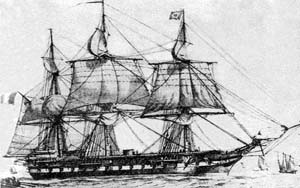Apurimac (frigate)

The frigate Apurímac under sail
|
|
| History | |
|---|---|
|
|
|
| Name: | Apurímac |
| Ordered: | August 1852 |
| Builder: | Richard & Henry Green Shipyard, Blackwall (United Kingdom) |
| Laid down: | 1853 |
| Launched: | July 1854 |
| Commissioned: | August 1855 |
| Renamed: | Callao (1858-1863) |
| Fate: | Scuttled to prevent capture in Callao harbor, January 16, 1881 |
| Notes: | Served as training ship from 1873 |
| General characteristics | |
| Class and type: | screw-propelled steam frigate |
| Tons burthen: | 1666 tons B.O.M. (British Old Measurement) |
| Length: | 62.17 m (204.0 ft) |
| Beam: | 13.10 m (43.0 ft) |
| Draft: | 7.16 m (23.5 ft) |
| Propulsion: |
|
| Sail plan: | Frigate sail rigging |
| Speed: |
|
| Complement: | 200 crewman |
| Armament: |
|
The Apurímac was the second steam frigate of the Peruvian Navy, built in England in 1855 along with the steamers Loa and Tumbes as a part of a major built-up of the Navy during the government of President José Rufino Echenique. A veteran of two wars and many internal conflicts, due to her age she served as training ship in Callao port from 1873 until January 17, 1881, when she was scuttled along with the rest of the Peruvian Navy to prevent capture by Chilean troops who had occupied the port after the defeat of the Peruvian Army in the battles of San Juan and Miraflores.
In 1852, Peru had one of South America's most powerful navies. It had two steam warships, the paddle steamer Rímac and the screw frigate Amazonas, and was surpassed in the region only by Brazil, the United States of America, and the Pacific fleets of France and England (which had also recently been reinforced with steam warships). To prevent a European intervention—the Royal Navy having had several encounters with the Peruvian Navy in 1830 and 1844—a commission was sent to England to order three more steam warships: two schooners, and the screw frigate Apurímac. This was ordered in August 1852, and built in the Richard & Henry Green Shipyard in London under the supervision of Chilean-born Captain Jose Maria Salcedo, who served in the Peruvian Navy. She was commissioned in August 1855, and arrived at the port of Callao on November 12, 1855.
On November 16, 1856 the frigate, anchored in Arica, was taken by two young officers in favor of Manuel Ignacio de Vivanco; these were Second Lieutenant Lizardo Montero and Lieutenant Miguel Grau, who took the opportunity to seize the ship when her commander, Captain José María Salcedo was on shore visiting the house of the local British Consul. The first action of the rebel ship was the release of political prisoners taken by President Ramon Castilla who were held in the hulks Caupolicán and Highlander in Arica.
...
Wikipedia
